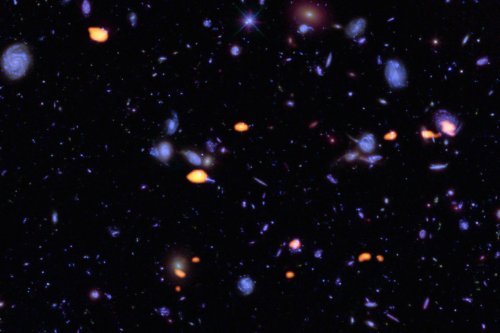ALMA Telescope has made the deepest dive in the depths of the Universe

An international team of scientists astronomv working with the most powerful to date, the radio telescope ALMA (Atacama Large Millimetre / submillimetre Array), made the observation of the field of space, examined earlier Hubble Space Telescope in the review Hubble Ultra Deep Field (HUDF). These findings, according to available data, are the most profound immersion into the universe in the history of astronomy. And, in addition to obtaining additional data about the earliest stages of the formation of the universe, observations allowed scientists to discover a new type of galaxy, a type that was not seen never before.
"We had never seen this type of galaxies" - says Chris Carrillo, the scientist-astronomer at the National Radio Astronomy Observatory (National Radio Astronomy Observatory), - "These galaxies contain very few stars, and they are filled with very dense clouds of cold gas." This discovery is yet another confirmation of the fact that the pace of the processes of formation of new stars in galaxies is related to the amount of the total mass of matter contained in the already established stars. This, in turn, explains some of the features of the burst about 10 billion years ago, the "golden age" of the universe, when the cosmos was the formation of the whole bulk of the stars and galaxies.

The ALMA radio telescope, as part of which there are 66 parabolic antennas, is the world's largest array of radio telescopes today, allows us to consider the depths of space in the millimeter and submillimeter wavelengths. This, in turn, allows you to see a faint light emitted by the clouds of gas and cosmic radiation from warm dust clouds that have existed in the universe at the very early stage of its formation.
During the last phase of the ALMA telescope watching areas HUDF for 50 hours. The photographs of near-infrared and millimeter wave are aligned with the Hubble Telescope images taken in visible and ultraviolet light, which made it possible to increase the information content of the data available to them. And this achievement is only the beginning of "fruitful cooperation" Hubble telescopes and ALMA. In the near future ALMA telescope will make repeated monitoring of areas HUDF, each of which will last for 150 hours. And this, in turn, will allow scientists to penetrate even deeper into the past of our universe.
Your article is a google translation of this original article. Not properly citing his/her source is a very bad practice. Moreover, google translations of any article will not bring much to the steemit platform. It is better to give a link to your sources and explain why you have liked the original article (i.e. starting a discussion).
The further they look, the more there more there is too see. The universe just keeps going....and going...and going...and going..